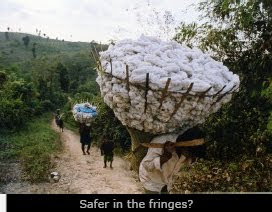The 16 Days Fortnight event at Xavier's institute of Social Sciences (XISS) on 5th Dec 2009 comprised of Film Screening, Quiz and Elocution.
KP Sasi's Redefining Peace a documentary was screened on Indian women leaders who were nominated for Nobel Peace Prize in 2005- Medha Patkar, Teesta Seetalwad, CK Janu, Irom Sharmila etc

The inaugural Address was given by Shravani and Dr Rose Kerketta, who have been part of the women's movement in Jharkhand and bring out a women magazine 'Adhi Duniya'.
Quiz Contest on Women and Violence Issues. There were five teams - Peace, Justice, Freedom, Equality, and Development. The Peace team comprising of Aastha Singh and Abhishek Chakravorty won.
Elocution Contest on the issue of
'My Perspective and Strategy for Countering Violence against Women' had 12 speakers, belonging to different streams of the Institute like rural management, marketing, personnel management and information management
. The winners were Soumya Rani Gouda (first), Soumyojjwal Dutta (second), Reeti, Isha and Anupam.
The guests who also judged during the competitions were Dr Usha (Psychologist), Dr Kiran (Sambhava Women magazine) and Sarjeet Singh.The program was organised under the banner of
Mahila Hinsa Pratirodh Pakhwara Aayojan Samiti which is collective of many women organisation and networks (GLRF, NAWO, Mahila Garima Abhiyan, etc)
Dr Kiran said it is very much wrong to say that domestic violence is promoted by women, as it is the patriarchal attitudes in which the society has been cultured. We need to hit at patriarchy, which might be present in women too, not solely a men issue.
Students expressed various opinions ...


- It is time for men and women to act beyond just talking about it. Boman Irani's (Bell Bajao) video spot which showed how people in one neighbourhood knock the door of someone engaging in domestic violence, need to be implemented.
- Men have looked at women just with eyes (concentrating on her beauty aspect) but now they have to use brains to look at women's other mental qualities too, which has been shown by Kiran Bedi and Arundhati Roy.
- Women should have the freedom to choose what they want to do as an individual, she should get dignity as a human being.
- There should be a policy of 'zero tolerance'. At least we students should feel it from our hearts and hope this effort kindles a new ray of hope amongst women.
- To counter violence against women, men need to be sensitised. Young men need to stand for women's human rights.
- The film has helped asserted and help us realise that women issues are beyond 'reproduction', to contribution in production and efforts to create peace.

The Quiz involved questions related to Syeda Hameed, Smita Patil, Mother Teresa, Sarojini Naidu, Meerabai, Roop Kanwar (Sati), film Provoked (on Kiranjeet Ahluwalia case in England), Seema Biswas (Bandit Queen), Arundhati Roy, Aruna Roy, Pandita Ramabai, Simone De Beauvoir, Deepa Mehta film Water (on widows), Mahasweta Devi, Kalpana Lajmi's Rudaali, Aung San Suu Kyi (Burma), PCPNDT Act, Vishakha Sexual Harassment Guidelines, Tasleema Nasreen's book Lajja, Jharkhand Archer Dola Banerjee, etc
The event was coordinated by Elina Horo, Vandana Tete, Sweta Kujur, Praveer Peter, Anima Baa, Shravani and Prabha Lakra. INTREND, the XISS club of students with Anupam, Anupriya, Rajat, Tuhin and Khushboo expressed that they would like to have more of such student activities and be in touch through blogs
www.lifeatxiss.blogspot.com and
www.openspace-ranchi.blogspot.com.





































